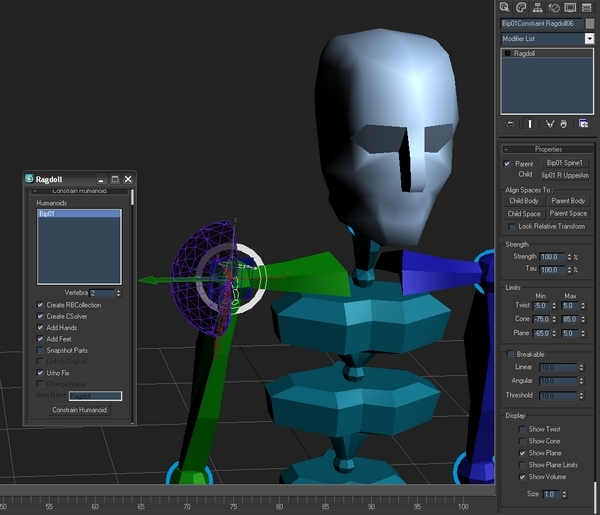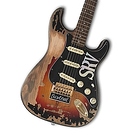[quote=“slapin”]Well, Blender rigidbody setup for a ragdoll is very diffrent from what it is in Urho, so the tools for ragdolls
need to be implemented as Urho tool.
As for your script for Max - could you explain theory behind it? How do you convert 3DSMax data
to Urho data, and what is source setup? That will quite probably give me some idea.[/quote]
3ds max comes with a built in ragdoll script that works strictly with max’s biped system.Basically the UI is one “Create Ragdoll” button.If you press the button the script will loop through the biped and assign constraints to specific biped bones.All limits , axes , parent / chilren hierarchy is automatically set up.The script uses two type of constraints : Hinge (which is the same as in Urho) and a constraint called “Ragdoll” which is more or less equal to Urho’s Conetwist.
After the script builds the ragdoll , it looks like this (Note the arrows that show the axes and the blue mesh shows the limits of the constraint.) :

Nearly without any modifications it is ready to export.I wrote an exporter that loops through the scene and writes the constraints data to a *.ragdoll file. (BoneCount , boneSize , contrainttype , parent , child , etc)
And i wrote a Ragdoll component which is basically the same as Urho’s ragdoll component except it reads and builds the ragdoll from my *.ragdoll script instead from static code.
I had to make some adjustments before i export : Some axes must be rotated 90 degs in some direction to match Urho’s space.(Note the “Urho fix” checkbox on the upper image)
So basically thats all.
here’s the constraint export function :
[code]
– 1 string child name
– 1 string parent name
– 1 int constraint type (0 hinge , 1 = conetwist)
– 1 2dvector min rotation
– 1 2dvector max rotation
– 1 quaternion child rotation
– 1 quaternion parent rotation
fn exportConstraints theFile childName parentName =
(
noConstraint = true
for c = 1 to objects.count do
(
if classof objects[c] == Hinge or classof objects[c] == Ragdoll then
(
noConstraint = false
if objects[c].parentBody.name == parentName and objects[c].childBody.name == childName then
(
pName = generateStandardName parentName
cName = generateStandardName childName
writeString theFile cName
writeString theFile pName
if classof objects[c] == Hinge then
(
writeLong theFile 0
writeFloat theFile objects[c].limitMinAngle
writeFloat theFile 0
writeFloat theFile objects[c].limitMaxAngle
writeFloat theFile 0
)
else -- It's a Conetwist (called Ragdoll in 3ds max)
(
writeLong theFile 1
writeFloat theFile objects[c].coneLimitMinAngle
writeFloat theFile objects[c].coneLimitMaxAngle
writeFloat theFile objects[c].coneLimitMinAngle
writeFloat theFile objects[c].coneLimitMaxAngle
)
childRotation = objects[c].childTransform.rotation
parentRotation = objects[c].parentTransform.rotation
writeFloat theFile childRotation.w
writeFloat theFile childRotation.x
writeFloat theFile childRotation.z
writeFloat theFile childRotation.y
writeFloat theFile parentRotation.w
writeFloat theFile parentRotation.x
writeFloat theFile parentRotation.z
writeFloat theFile parentRotation.y
Print ("Export Constraint with parent : " + parentName + " -- and child : " + childName)
)
else
(
MessageBox ("Constraint with parent : " + parentName + " and child : " + childName + " does not exist")
)
)
)
if noConstraint then MessageBox ("No constraint found in the scene")
)[/code]
And here’s the rigidBody export function
[code]
– 1 int collision type (0 = box 1= capsule)
– 1 string bone name
– 1 vector3
fn writeRagdollBoneData theFile theName collisionType =
(
writeLong theFile collisionType
body = findObjectByName theName
bb = nodeGetboundingBox body body.transform
size = bb[2] - bb[1]
size.x = abs(size.x)
size.y = abs(size.y)
size.z = abs(size.z)
st = generateStandardName body.name
writeString theFile st
-- Special case to these bones.A little correction to make the collision jitterles.
if st == "Bip01_L_Calf" or st == "Bip01_R_Calf" or st == "Bip01_L_Forearm" or st == "Bip01_R_Forearm" then size.x *= 1.2
writeFloat theFile size.x
writeFloat theFile size.z
writeFloat theFile size.y
)[/code]
and finally here’s the ragdoll data exporter , using these two functions :
-- 1 int num affected bones
-- 1 int collision type (0 box , 1 = capsule)
-- 1 string = bone name
-- 1 vector = size
fn exportRagdoll theFile =
(
writeLong theFile 11
writeRagdollBoneData theFile "Bip01 Pelvis" 0
writeRagdollBoneData theFile "Bip01 Spine1" 0
writeRagdollBoneData theFile "Bip01 L Thigh" 1
writeRagdollBoneData theFile "Bip01 R Thigh" 1
writeRagdollBoneData theFile "Bip01 L Calf" 1
writeRagdollBoneData theFile "Bip01 R Calf" 1
writeRagdollBoneData theFile "Bip01 Head" 0
writeRagdollBoneData theFile "Bip01 L UpperArm" 1
writeRagdollBoneData theFile "Bip01 R UpperArm" 1
writeRagdollBoneData theFile "Bip01 L Forearm" 1
writeRagdollBoneData theFile "Bip01 R Forearm" 1
-- export constraints :
-- num constraints
writeLong theFile 10
exportConstraints theFile "Bip01 L Thigh" "Bip01 Pelvis"
exportConstraints theFile "Bip01 R Thigh" "Bip01 Pelvis"
exportConstraints theFile "Bip01 L Calf" "Bip01 L Thigh"
exportConstraints theFile "Bip01 R Calf" "Bip01 R Thigh"
exportConstraints theFile "Bip01 Spine1" "Bip01 Pelvis"
exportConstraints theFile "Bip01 Head" "Bip01 Spine1"
exportConstraints theFile "Bip01 L UpperArm" "Bip01 Spine1"
exportConstraints theFile "Bip01 R UpperArm" "Bip01 Spine1"
exportConstraints theFile "Bip01 L Forearm" "Bip01 L UpperArm"
exportConstraints theFile "Bip01 R Forearm" "Bip01 R UpperArm"
)


